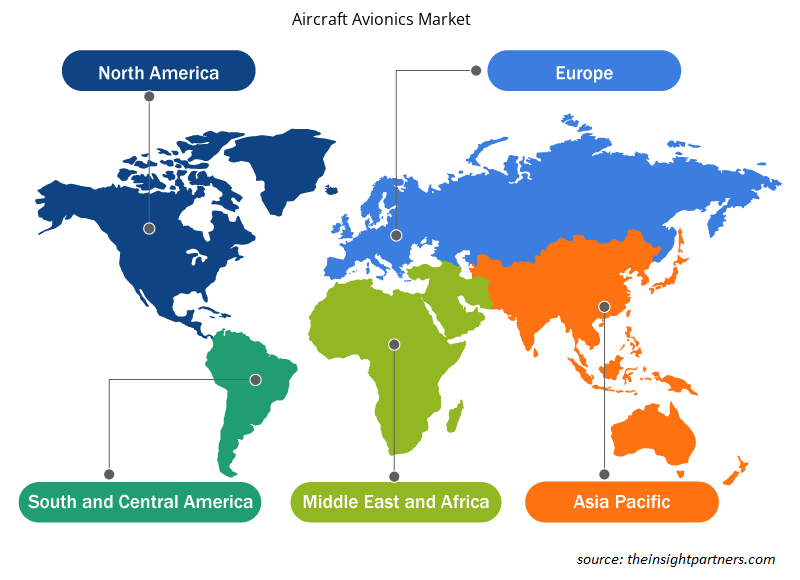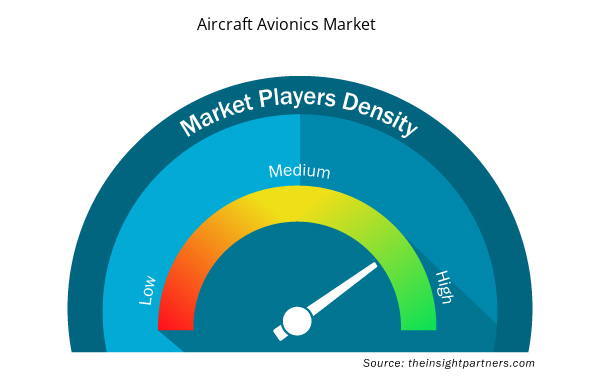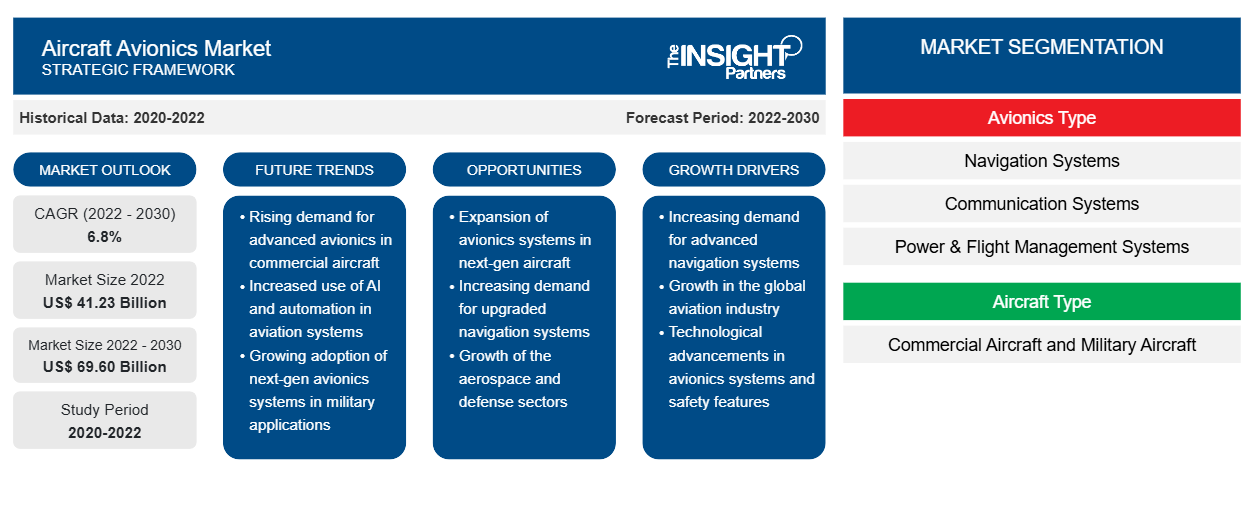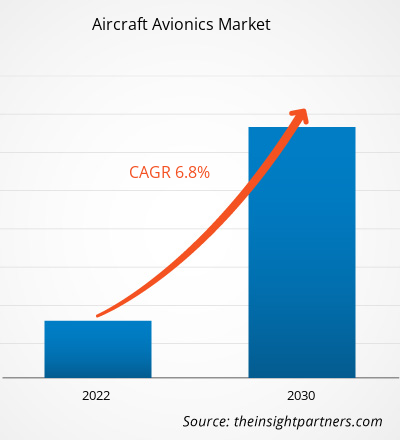[Forschungsbericht] Der Markt für Flugzeugavionik soll von 41,23 Milliarden US-Dollar im Jahr 2022 auf 69,60 Milliarden US-Dollar im Jahr 2030 wachsen; von 2022 bis 2030 wird eine durchschnittliche jährliche Wachstumsrate (CAGR) von 6,8 % erwartet.
Analystenperspektive:
Der Markt für Flugzeugavionik hat in den letzten Jahren ein enormes Wachstum erlebt. Einer der Hauptfaktoren, die das Wachstum der Flugzeugavionik vorantreiben, ist die wachsende globale Flugzeugflotte und die Überholung älterer Flugzeugflotten. Ein weiterer wichtiger Faktor, der das Wachstum des Flugzeugavionikmarktes vorantreibt, ist die zunehmende Elektrifizierung von Flugzeugkomponenten, die auch den Bedarf an elektronischen Steuerungen für Piloten erzeugt, die das Flugzeug steuern. Hersteller von Flugzeugavionik konzentrieren sich hauptsächlich auf die Entwicklung innovativer Produkte, um auf dem Markt wettbewerbsfähig zu bleiben. Einige der Faktoren, die den Markt jedoch vor Herausforderungen stellen, sind zunehmende Umweltbedenken aufgrund des Flugzeugbetriebs und höhere Installationskosten für Avionikkomponenten.
Marktübersicht:
Der Markt für Flugzeugavionik dürfte in den kommenden Jahren ein gesundes Wachstum verzeichnen. Dies ist hauptsächlich auf die erwarteten Flugzeugauslieferungen in den kommenden Jahren zurückzuführen. Laut dem Bericht „Commercial Market Outlook (CMO) 2023“ von Boeing beispielsweise werden die Fluggesellschaften in den nächsten 20 Jahren voraussichtlich 42.595 neue Verkehrsflugzeuge benötigen, um den schnell wachsenden Fluggastverkehr zu bewältigen. Dem Bericht „Global Market Forecasts (GMF)“ von Airbus zufolge werden die Fluggesellschaften bis Ende 2042 voraussichtlich rund 40.850 neue Flugzeuge beschaffen. Solche Faktoren werden in den kommenden Jahrzehnten voraussichtlich enorme Chancen für Anbieter auf dem Markt für Flugzeugavionik schaffen, und es wird erwartet, dass im selben Zeitraum auch eine enorme Nachfrage nach anderen Flugzeugkomponenten entsteht. Darüber hinaus sind die zunehmende Elektrifizierung von Flugzeugkomponenten und die Umstellung von mechanischen auf elektrische Komponenten des Flugzeugs einige der anderen Faktoren, die das Wachstum des Marktes für Flugzeugavionik in verschiedenen Regionen vorantreiben.
Passen Sie diesen Bericht Ihren Anforderungen an
Sie erhalten kostenlos individuelle Anpassungen an jedem Bericht, einschließlich Teilen dieses Berichts oder einer Analyse auf Länderebene, eines Excel-Datenpakets sowie tolle Angebote und Rabatte für Start-ups und Universitäten.
- Holen Sie sich die wichtigsten Markttrends aus diesem Bericht.Dieses KOSTENLOSE Beispiel umfasst eine Datenanalyse von Markttrends bis hin zu Schätzungen und Prognosen.
Markttreiber:
Wachsende MRO-Branche schafft neue Nachfrage nach Flugzeugavionik
Retrofitting, also die Installation oder Ergänzung neuerer Technologien in älteren Flugzeugflotten, trägt zu mehr Komfort und Sicherheit für die Passagiere bei und erleichtert den Fluggesellschaften die Wartung ihrer älteren Flotten. Kontinuierliche Fortschritte in der Flugzeugtechnologie führen zu einer Verbesserung der MRO-Kapazitäten. MRO-Dienstleister sind ständig auf der Suche nach Upgrades und Beschaffung neuerer Technologien, um die neueren Flugzeuge zu warten und die verbesserten Technologien in den älteren Flugzeugflotten nachzurüsten. In der aktuellen Situation halten globale kommerzielle Fluggesellschaften aufgrund der sinkenden Treibstoffpreise an ihrer älteren Flugzeugflotte fest. Dieser Faktor zwingt die Fluggesellschaften, sich häufig für MRO-Aktivitäten zu entscheiden, was es den MRO-Dienstleistern erleichtert, den Fluggesellschaften die Nachrüstung der Flugzeugflotte mit neueren Technologien anzubieten. Der Retrofitting-Trend nimmt bei den MRO-Dienstleistern stark zu. Daher wird erwartet, dass die Integration fortschrittlicher und moderner Technologien wie fortschrittlicher Flugzeugelektronik einschließlich der Avioniksysteme in ältere Flugzeugflotten die Marktlandschaft für Flugzeugavionik sowie das Gesicht der Luftfahrtindustrie in den kommenden Jahren vorantreiben wird.
Insbesondere in technologisch hochentwickelten Regionen wie Europa und Nordamerika steigt die Nachfrage nach Echtzeit-Datenanalysen, da dort die Einführung der oben genannten Technologien exponentiell voranschreitet.
Segmentanalyse:
Basierend auf dem Avioniktyp ist der Markt in Navigationssysteme, Kommunikationssysteme, Energie- und Flugmanagementsysteme , Wetterüberwachungssysteme, elektronische Fluganzeige und andere unterteilt. Das Segment Energie- und Flugmanagementsysteme hatte 2022 den größten Marktanteil und wird seine Dominanz voraussichtlich auch zwischen 2022 und 2030 beibehalten. Darüber hinaus wird erwartet, dass die Energie- und Flugmanagementsysteme zwischen 2022 und 2030 die höchste durchschnittliche jährliche Wachstumsrate auf dem Markt für Flugzeugavionik verzeichnen werden. Der Hauptfaktor für den größten Marktanteil des Segments Energie- und Flugmanagementsysteme ist sein höherer Preis, seine Technologieintegration und dass es einer der wichtigsten Controller für den Piloten ist, der ihm während jedes Fluges die Sichtbarkeit des Flugzeugbetriebs ermöglicht. Darüber hinaus wird die Nachfrage nach dem Segment Energie- und Flugmanagementsysteme auch dadurch getrieben, dass Energie- und Flugmanagementsysteme bei den meisten Flugzeugoperationen während eines Flugs eingesetzt werden. Darüber hinaus ist die Notwendigkeit, ein besseres Management der Flugkomponenten und den Echtzeitstatus der Flugsteuerung bereitzustellen, ein weiterer wichtiger Faktor, der das Wachstum des Marktes für Flugzeugavionik in verschiedenen Regionen vorantreibt.
Regionale Analyse:
Der nordamerikanische Markt für Flugzeugavionik wurde im Jahr 2022 auf 13,26 Milliarden US-Dollar geschätzt und soll bis 2030 21,24 Milliarden US-Dollar erreichen; für den Zeitraum 2022 bis 2030 wird eine durchschnittliche jährliche Wachstumsrate von 6,1 % erwartet. In der Region Nordamerika sind einige der wichtigsten Flugzeughersteller angesiedelt, darunter Boeing, Bombardier, Lockheed Martin und Airbus, die ihre jeweiligen Produktionsstätten in verschiedenen Teilen der Region haben und von ihren jeweiligen Standorten aus eine ständige Nachfrage nach Flugzeugelektronikprodukten erzeugen. Dieser Faktor hat das Wachstum von Flugzeugavionikprodukten in der gesamten Region vorangetrieben. Ein weiterer wichtiger Faktor, der das Wachstum des nordamerikanischen Marktes für Flugzeugavionik katalysiert, ist die Präsenz von Flugzeugavionikherstellern in Ländern wie den USA und Kanada. Zu diesen Unternehmen gehören Anbieter wie Raytheon Technologies Corporation, Curtiss-Wright Corporation, Honeywell International Inc, General Electric Company, Moog Inc und BAE Systems Plc.
Schlüsselspieleranalyse:
Die Marktanalyse für Flugzeugavionik umfasst Akteure wie L3Harris Technologies Inc, Raytheon Technologies Corporation, Curtiss-Wright Corporation, Honeywell International Inc, General Electric Company, Safran SA, BAE Systems Plc, Moog Inc, Meggitt Plc und Garmin Ltd. Unter den genannten Akteuren auf dem Markt für Flugzeugavionik sind BAE Systems Plc, Raytheon Technologies Corporation, General Electric, Meggitt Plc und Curtiss-Wright Corporation aufgrund ihres diversifizierten Produktportfolios einige der führenden Akteure auf dem Markt für Flugzeugavionik.
Regionale Einblicke in den Flugzeugavionikmarkt
Die regionalen Trends und Faktoren, die den Markt für Flugzeugavionik im Prognosezeitraum beeinflussen, wurden von den Analysten von Insight Partners ausführlich erläutert. In diesem Abschnitt werden auch die Marktsegmente und die Geografie für Flugzeugavionik in Nordamerika, Europa, im asiatisch-pazifischen Raum, im Nahen Osten und Afrika sowie in Süd- und Mittelamerika erörtert.

- Erhalten Sie regionale Daten zum Flugzeugavionikmarkt
Umfang des Marktberichts zur Flugzeugavionik
| Berichtsattribut | Details |
|---|---|
| Marktgröße im Jahr 2022 | 41,23 Milliarden US-Dollar |
| Marktgröße bis 2030 | 69,60 Milliarden US-Dollar |
| Globale CAGR (2022 - 2030) | 6,8 % |
| Historische Daten | 2020-2022 |
| Prognosezeitraum | 2022–2030 |
| Abgedeckte Segmente | Nach Avioniktyp
|
| Abgedeckte Regionen und Länder | Nordamerika
|
| Marktführer und wichtige Unternehmensprofile |
|
Marktteilnehmerdichte: Der Einfluss auf die Geschäftsdynamik
Der Markt für Flugzeugavionik wächst rasant, angetrieben durch die steigende Endverbrauchernachfrage aufgrund von Faktoren wie sich entwickelnden Verbraucherpräferenzen, technologischen Fortschritten und einem größeren Bewusstsein für die Vorteile des Produkts. Mit steigender Nachfrage erweitern Unternehmen ihr Angebot, entwickeln Innovationen, um die Bedürfnisse der Verbraucher zu erfüllen, und nutzen neue Trends, was das Marktwachstum weiter ankurbelt.
Die Marktteilnehmerdichte bezieht sich auf die Verteilung von Firmen oder Unternehmen, die in einem bestimmten Markt oder einer bestimmten Branche tätig sind. Sie gibt an, wie viele Wettbewerber (Marktteilnehmer) in einem bestimmten Marktraum im Verhältnis zu seiner Größe oder seinem gesamten Marktwert präsent sind.
Die wichtigsten auf dem Markt für Flugzeugavionik tätigen Unternehmen sind:
- L3Harris Technologies Inc
- Raytheon Technologies Corporation
- Curtiss-Wright Corporation
- Honeywell International Inc
- Allgemeine Elektricitätsgesellschaft
Haftungsausschluss : Die oben aufgeführten Unternehmen sind nicht in einer bestimmten Reihenfolge aufgeführt.

- Überblick über die wichtigsten Akteure auf dem Markt für Flugzeugavionik
Aktuelle Entwicklungen:
Anorganische und organische Strategien wie Produkteinführungen, Fusionen und Übernahmen werden von Unternehmen auf dem Markt für Flugzeugavionik häufig eingesetzt. So unterzeichneten GE Aerospace und AJW Group im April 2023 eine Vereinbarung zur Unterstützung von Avionik- und Stromversorgungssystemen für die Flugzeugmodelle B777, B737 und A320/30/40. Ebenso unterzeichnete HAL (Hindustan Aeronautics Limited) im Dezember 2021 einen Vertrag im Wert von 288 Millionen US-Dollar mit BEL (Bharat Electricals Limited) zur Lieferung von Avionikkomponenten für das Kampfflugzeugprogramm LCA Tejas Mk1A. Solche Faktoren treiben auch das Wachstum des Marktes für Flugzeugavionik aus Sicht der Zulieferer voran.
- Historische Analyse (2 Jahre), Basisjahr, Prognose (7 Jahre) mit CAGR
- PEST- und SWOT-Analyse
- Marktgröße Wert/Volumen – Global, Regional, Land
- Branche und Wettbewerbsumfeld
- Excel-Datensatz



Report Coverage
Revenue forecast, Company Analysis, Industry landscape, Growth factors, and Trends

Segment Covered
This text is related
to segments covered.

Regional Scope
North America, Europe, Asia Pacific, Middle East & Africa, South & Central America

Country Scope
This text is related
to country scope.
Häufig gestellte Fragen
The rising global aircraft fleet; growing MRO industry; and accentuating aircraft order and delivery volumes are contributing to the growth of aircraft avionics market.
Integration of advanced artificial intelligent technologies into aircraft avionics is one of the major trends expected to drive the market in the coming years.
L3Harris Technologies Inc, Raytheon Technologies Corporation, Curtiss-Wright Corporation, Honeywell International Inc, and General Electric are some of the key market players operating in the global aircraft avionics market.
Retrofitting of older aircraft fleet and the expected aircraft deliveries in the coming years are some of the key factors likely to generate new opportunities for market vendors during the forecast period.
North America is expected to account for the largest share during the forecast period; however, Asia Pacific is likely to surpass North America by 2026 and is expected to dominate the global aircraft avionics market by 2030.
Trends and growth analysis reports related to Aerospace and Defense : READ MORE..
The List of Companies - Aircraft Avionics Systems Market
- L3Harris Technologies Inc
- Raytheon Technologies Corporation
- Curtiss-Wright Corporation
- Honeywell International Inc
- General Electric Company
- Safran SA
- BAE Systems Plc
- Moog Inc
- Meggitt Plc
- Garmin Ltd
The Insight Partners performs research in 4 major stages: Data Collection & Secondary Research, Primary Research, Data Analysis and Data Triangulation & Final Review.
- Data Collection and Secondary Research:
As a market research and consulting firm operating from a decade, we have published and advised several client across the globe. First step for any study will start with an assessment of currently available data and insights from existing reports. Further, historical and current market information is collected from Investor Presentations, Annual Reports, SEC Filings, etc., and other information related to company’s performance and market positioning are gathered from Paid Databases (Factiva, Hoovers, and Reuters) and various other publications available in public domain.
Several associations trade associates, technical forums, institutes, societies and organization are accessed to gain technical as well as market related insights through their publications such as research papers, blogs and press releases related to the studies are referred to get cues about the market. Further, white papers, journals, magazines, and other news articles published in last 3 years are scrutinized and analyzed to understand the current market trends.
- Primary Research:
The primarily interview analysis comprise of data obtained from industry participants interview and answers to survey questions gathered by in-house primary team.
For primary research, interviews are conducted with industry experts/CEOs/Marketing Managers/VPs/Subject Matter Experts from both demand and supply side to get a 360-degree view of the market. The primary team conducts several interviews based on the complexity of the markets to understand the various market trends and dynamics which makes research more credible and precise.
A typical research interview fulfils the following functions:
- Provides first-hand information on the market size, market trends, growth trends, competitive landscape, and outlook
- Validates and strengthens in-house secondary research findings
- Develops the analysis team’s expertise and market understanding
Primary research involves email interactions and telephone interviews for each market, category, segment, and sub-segment across geographies. The participants who typically take part in such a process include, but are not limited to:
- Industry participants: VPs, business development managers, market intelligence managers and national sales managers
- Outside experts: Valuation experts, research analysts and key opinion leaders specializing in the electronics and semiconductor industry.
Below is the breakup of our primary respondents by company, designation, and region:

Once we receive the confirmation from primary research sources or primary respondents, we finalize the base year market estimation and forecast the data as per the macroeconomic and microeconomic factors assessed during data collection.
- Data Analysis:
Once data is validated through both secondary as well as primary respondents, we finalize the market estimations by hypothesis formulation and factor analysis at regional and country level.
- Macro-Economic Factor Analysis:
We analyse macroeconomic indicators such the gross domestic product (GDP), increase in the demand for goods and services across industries, technological advancement, regional economic growth, governmental policies, the influence of COVID-19, PEST analysis, and other aspects. This analysis aids in setting benchmarks for various nations/regions and approximating market splits. Additionally, the general trend of the aforementioned components aid in determining the market's development possibilities.
- Country Level Data:
Various factors that are especially aligned to the country are taken into account to determine the market size for a certain area and country, including the presence of vendors, such as headquarters and offices, the country's GDP, demand patterns, and industry growth. To comprehend the market dynamics for the nation, a number of growth variables, inhibitors, application areas, and current market trends are researched. The aforementioned elements aid in determining the country's overall market's growth potential.
- Company Profile:
The “Table of Contents” is formulated by listing and analyzing more than 25 - 30 companies operating in the market ecosystem across geographies. However, we profile only 10 companies as a standard practice in our syndicate reports. These 10 companies comprise leading, emerging, and regional players. Nonetheless, our analysis is not restricted to the 10 listed companies, we also analyze other companies present in the market to develop a holistic view and understand the prevailing trends. The “Company Profiles” section in the report covers key facts, business description, products & services, financial information, SWOT analysis, and key developments. The financial information presented is extracted from the annual reports and official documents of the publicly listed companies. Upon collecting the information for the sections of respective companies, we verify them via various primary sources and then compile the data in respective company profiles. The company level information helps us in deriving the base number as well as in forecasting the market size.
- Developing Base Number:
Aggregation of sales statistics (2020-2022) and macro-economic factor, and other secondary and primary research insights are utilized to arrive at base number and related market shares for 2022. The data gaps are identified in this step and relevant market data is analyzed, collected from paid primary interviews or databases. On finalizing the base year market size, forecasts are developed on the basis of macro-economic, industry and market growth factors and company level analysis.
- Data Triangulation and Final Review:
The market findings and base year market size calculations are validated from supply as well as demand side. Demand side validations are based on macro-economic factor analysis and benchmarks for respective regions and countries. In case of supply side validations, revenues of major companies are estimated (in case not available) based on industry benchmark, approximate number of employees, product portfolio, and primary interviews revenues are gathered. Further revenue from target product/service segment is assessed to avoid overshooting of market statistics. In case of heavy deviations between supply and demand side values, all thes steps are repeated to achieve synchronization.
We follow an iterative model, wherein we share our research findings with Subject Matter Experts (SME’s) and Key Opinion Leaders (KOLs) until consensus view of the market is not formulated – this model negates any drastic deviation in the opinions of experts. Only validated and universally acceptable research findings are quoted in our reports.
We have important check points that we use to validate our research findings – which we call – data triangulation, where we validate the information, we generate from secondary sources with primary interviews and then we re-validate with our internal data bases and Subject matter experts. This comprehensive model enables us to deliver high quality, reliable data in shortest possible time.


 Holen Sie sich ein kostenloses Muster für diesen Bericht
Holen Sie sich ein kostenloses Muster für diesen Bericht